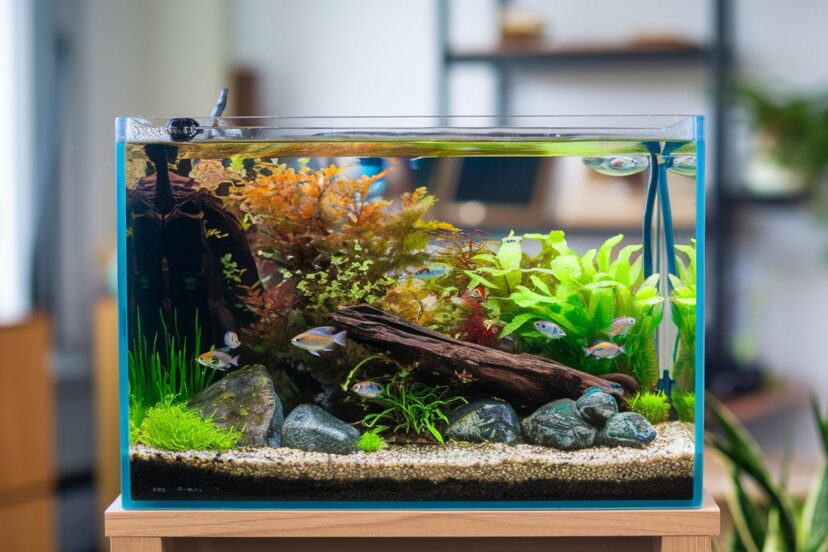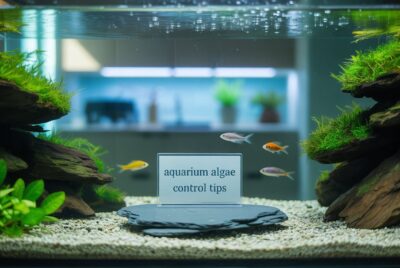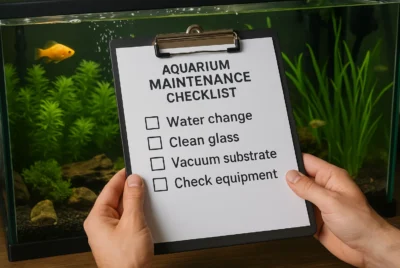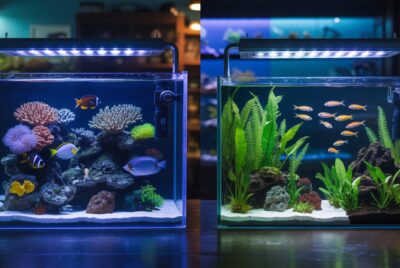Nano Aquariums 101
*We may earn a commission for purchases made using our links. Please see our disclosure to learn more.
The sound of gently bubbling water, flashes of color as tiny fish dart between plants, and a miniature underwater landscape that changes and grows right before your eyes, this is the captivating world of nano aquariums. I discovered these compact underwater ecosystems three years ago when my apartment downsizing left no room for my 55-gallon tank. What started as a compromise quickly became a passion that I’m excited to share with you today.
Key Takeaways
- Nano aquariums (typically under 10 gallons) offer a space-efficient way to enjoy the aquarium hobby
- These small tanks require careful attention to water parameters and maintenance
- Plant selection is crucial for both aesthetics and maintaining water quality
- Specialized equipment designed for nano tanks ensures optimal conditions
- Fish and invertebrate selection must be appropriate for the limited space
- With proper setup and care, nano tanks can be stable, thriving ecosystems
“The smaller the tank, the bigger the challenge, but also the greater the reward when you create that perfect, balanced ecosystem that thrives within such limited boundaries.”
— Dr. Patrick Sugrue, Marine Biologist and author of “Small Scale Aquatics”
Best Nano Aquarium Products
Based on my personal experience and extensive research, here are four standout nano aquarium products:
Fluval Spec V 5-Gallon Aquarium Kit
The Fluval Spec V Aquarium Kit is a sleek, modern 5-gallon nano aquarium perfect for desktops, counters, and small spaces. Featuring a beautifully etched glass tank with elegant aluminum trim, it brings a touch of sophistication to your home or office. The powerful 37 LED lighting system enhances the vibrant colors of your aquatic life, while the integrated filtration system ensures a clean and healthy environment. Complete with foam block, activated carbon, and BioMax bio rings, this compact tank is ideal for beginners and hobbyists alike.
- Compact Design: Fits easily on desks and small spaces without sacrificing style.
- Built-In Filtration: Comes with a multi-stage filter for clear, healthy water.
- LED Lighting: Enhances fish colors and supports low-light plants.
- Limited Space: Not suitable for larger fish or high bio-load setups.
- Small Opening: Cleaning and maintenance may be slightly tricky.
- Pricey for Size: Higher cost compared to some other 5-gallon kits.
This sleek, all-in-one system includes a powerful three-stage filtration system and 37 LED lighting fixture. What I love most about this tank is its hidden filtration compartment that keeps equipment out of sight while maintaining excellent water quality. The elongated design provides plenty of swimming space despite its modest volume.
Cobalt Aquatics Microvue3 Aquarium Kit
The Cobalt Aquatics Microvue3 Aquarium Kit is a compact yet elegant 2.6-gallon glass cube designed for modern living spaces. With its crystal-clear glass construction and sleek white/black finish, it’s perfect for showcasing vibrant aquatic life. This nano tank comes complete with a Clearvue 20 internal filter, a 6-watt LED light, a foam pad, and a glass top—everything you need for a stylish freshwater or nano reef setup. Whether you’re housing bettas, shrimp, glow fish, or plants, this aquarium offers a versatile and reliable home for small aquatic environments.
- Clear Glass Design: Offers excellent clarity and a modern look for stylish displays.
- Versatile Use: Great for bettas, shrimp, nano reefs, or planted tanks.
- Complete Kit: Includes filter, LED light, foam pad, and glass top.
- Small Capacity: 2.6 gallons limits fish and plant selection.
- Light Output: LED may not be strong enough for demanding plants.
- Limited Space for Upgrades: Less room for additional equipment or decor.
At 3 gallons, this tank features a unique curved front that creates a stunning viewing angle. It comes with an integrated filter system and adjustable LED lighting. The small footprint makes it perfect for desktops, and the quality construction ensures durability.
LANDEN 15.6 Gallon Cube Aquarium
Elevate your aquascaping with the LANDEN 15.6 Gallon Cube Aquarium, designed for clarity, elegance, and functionality. Crafted with ultra-clear low-iron glass offering 91% light transmittance, this modern, rimless cube provides an unobstructed view of your aquatic world. Its minimalist design, flawless silicone seams, and precision-polished edges make it an ideal centerpiece for planted tanks or artistic aquascapes. The included nano foam leveling mat ensures stability and safety, while the sturdy 6mm glass construction delivers long-lasting durability. A perfect choice for aquarists who value quality and clean aesthetics.
- Ultra-Clear Glass: 91% light transmittance for true-to-life viewing.
- Modern Rimless Design: Sleek and seamless look enhances any space.
- Durable Build: Thick 6mm glass with expert craftsmanship ensures longevity.
- No Accessories Included: Requires separate purchase of filter, light, and heater.
- Heavy Weight: Nearly 30 lbs, not ideal for all surfaces or frequent moves.
- Higher Price Point: Premium materials come with a steeper investment.
For aquarists who demand the best, this 15.6-gallon rimless cube aquarium delivers exceptional clarity with its low-iron glass, offering a crystal-clear view from every angle. Although it doesn’t come with equipment, this gives you the flexibility to personalize your setup. I especially love the sleek, precision-polished edges and nearly invisible silicone seams that add to its sophisticated, minimalist design.
Hygger Horizon 8-Gallon LED Glass Aquarium Kit
The hygger Horizon 8 Gallon LED Glass Aquarium Kit is the perfect choice for beginners looking to create a vibrant aquatic environment. This stylish semi-circular tank includes an 18W multi-colored LED light, adjustable power filter pump, and a stunning 3D rockery mountain background for a dreamlike underwater effect. The tank’s wide-view curved design enhances the display, while the LED light offers customizable settings for brightness and color, allowing you to create the perfect ambiance. Ideal for small fish, shrimp, or plants, this easy-to-clean aquarium kit brings both function and beauty to your home.
- Multi-Mode LED Lighting: Adjustable brightness and color modes for diverse aquarium setups.
- Built-In 3D Background: Adds visual depth and provides hiding spots for fish.
- Quiet Power Filter: Efficient 7W filter with two-stage filtration for cleaner water.
- Limited Water Volume: Holds up to 6 gallons of water due to the 3D decor.
- Filter Strength: May be too powerful for small fish under 2 inches.
- Tank Weight: Full tank weighs about 68 lbs, making it less portable.
This innovative tank features a 3D rock background that adds depth and creates natural hiding places. The included filtration system and adjustable LED lighting make it ready to set up right out of the box. It’s an excellent value for beginners looking for an all-inclusive package.
What Makes a Nano Aquarium Special?
When I first ventured into the world of nano aquariums, I was skeptical about whether such small tanks could truly support healthy aquatic life. After all, conventional wisdom in the aquarium hobby has long held that “bigger is better” and “bigger is more stable.” But I’ve since discovered that nano tanks offer unique advantages and opportunities that larger setups simply can’t match.
Nano aquariums are generally considered to be tanks under 10 gallons, with many popular options falling in the 2.5 to 5-gallon range. Their compact size makes them perfect for urban dwellers, college dorms, offices, or anyone with limited space. But beyond the practical benefits of their small footprint, nano tanks offer an opportunity to create intricate, detailed aquascapes that would be difficult to achieve in larger tanks.
The smaller scale allows for a focused, deliberate approach to design. Every rock, plant, and decoration takes on greater significance when working in a confined space. It’s like the difference between painting a mural and creating a miniature, the attention to fine details becomes paramount.
Setting Up Your Nano Aquarium
When I set up my first nano tank, I made the rookie mistake of rushing the process, and learned my lesson the hard way. Small tanks require even more patience and preparation than their larger counterparts.
Choosing the Right Location
Placement is critical for nano aquariums. I’ve found that keeping them away from direct sunlight prevents excessive algae growth, while avoiding heating vents or air conditioners helps maintain stable water temperatures. A sturdy, level surface is essential, remember that even a small tank will weigh approximately 8-10 pounds per gallon when filled.
Consider visibility when choosing a location. My desktop nano tank sits at eye level when I’m working, providing a constant source of relaxation throughout the day.
Substrate Selection
The substrate serves both aesthetic and functional purposes in a nano tank. For planted tanks, I recommend an aquarium soil like Fluval Stratum or ADA Aquasoil, which provides essential nutrients for plant growth. A depth of 1-2 inches is typically sufficient in a nano tank.
If plants aren’t your priority, fine gravel or sand can create a clean, minimalist look. Dark substrates often make fish colors pop while hiding detritus until it can be removed during maintenance.
Filtration Considerations
Despite their size, nano tanks shouldn’t skimp on filtration. In fact, maintaining water quality is even more critical in smaller volumes where pollutants can quickly reach harmful concentrations.
I prefer sponge filters for nano tanks because they provide mechanical and biological filtration without creating strong currents that can stress small fish. For those who prefer hang-on-back filters, look for adjustable flow rates to prevent turning your tiny tank into a whirlpool.
Remember that filter media should be rinsed in old tank water during maintenance, never under tap water, which can kill beneficial bacteria.
Lighting for Small Spaces
Lighting serves multiple purposes in nano aquariums. Beyond illuminating your aquascape, it supports plant photosynthesis and establishes day/night cycles for inhabitants.
Modern LED lights offer significant advantages for nano tanks: they produce minimal heat (important in small water volumes), consume little electricity, and often include customizable settings. I’ve had excellent results with the Finnex Stingray for low-light setups and the Fluval Plant 3.0 Nano for more demanding planted tanks.
A timer is an invaluable accessory, ensuring consistent lighting periods of 8-10 hours daily. This consistency prevents algae issues while supporting healthy plant growth.
Stocking Your Nano Aquarium
The limited volume of nano tanks requires careful consideration when selecting inhabitants. The general rule of one inch of fish per gallon doesn’t apply well to nano tanks, I recommend stocking even more conservatively.
Appropriate Fish Species
Not all fish are suitable for nano aquariums. Species that remain small throughout their lives and have modest activity levels make the best candidates. Some of my favorite nano tank residents include:
- Betta splendens (Siamese Fighting Fish): These colorful fish with flowing fins make excellent solo specimens in 5-gallon tanks. Contrary to popular belief, they require heated, filtered environments, not tiny bowls.
- Microrasboras: Species like the Chili Rasbora (Boraras brigittae) grow to less than an inch and can be kept in small groups in tanks as small as 5 gallons.
- Endlers Livebearers: These colorful relatives of guppies stay smaller than their common cousins and bring vibrant activity to nano tanks.
- Ember Tetras: At around 3/4 inch when fully grown, these peaceful, orange-red fish add a warm glow to planted nano aquascapes.
- Celestial Pearl Danios: These tiny spotted fish resemble miniature trout and add interest to the middle water column.
Remember that smaller tanks benefit from species that utilize different tank levels, creating a more balanced appearance and reducing competition for territory.
The Invertebrate Advantage
Some of the most fascinating nano tank inhabitants aren’t fish at all. Invertebrates often have lower bioloads and unique behaviors that make them ideal for small setups:
- Cherry Shrimp (Neocaridina davidi): These bright red shrimp are constantly active, grazing on surfaces throughout the tank. They reproduce readily in healthy conditions, creating self-sustaining colonies.
- Amano Shrimp (Caridina multidentata): Slightly larger than cherry shrimp, these efficient algae eaters help maintain tank cleanliness.
- Nerite Snails: These attractive snails come in various patterns and are prized for their appetite for algae. Unlike many snails, they won’t reproduce in freshwater, preventing population explosions.
- Thai Micro Crabs: These tiny, peaceful crustaceans remain under an inch in size and add unique interest to nano communities.
In my experience, invertebrate-only tanks can be among the most fascinating nano setups, offering complex behaviors and interactions without the higher bioload of fish.
Planted Nano Aquariums
Plants aren’t just decorative elements in nano tanks, they’re crucial components of a healthy ecosystem. They absorb nitrates, provide oxygen, and create microhabitats for tank inhabitants.
Best Plants for Nano Tanks
Not all aquatic plants are suitable for small tanks. Species that grow rapidly or reach large sizes will quickly overwhelm limited space. My go-to plants for nano setups include:
- Anubias nana ‘Petite’: This slow-growing plant with small, round leaves can be attached to hardscape and requires minimal light.
- Bucephalandra species: These compact plants offer unique textures and colors, attaching easily to rocks and driftwood.
- Monte Carlo (Micranthemum tweediei): This low-growing carpeting plant creates lush green fields under moderate lighting.
- Java Moss (Taxiphyllum barbieri): Versatile and undemanding, this moss can be used to create natural-looking accents on hardscape.
- Cryptocoryne wendtii ‘Tropica’: This smaller variety of crypt offers attractive bronze-green leaves without outgrowing nano tanks.
- Hygrophila pinnatifida: With its unique leaf structure and compact growth habit, this plant adds vertical interest without dominating the space.
I’ve found that focusing on slow-growing species reduces maintenance requirements while creating more stable conditions in the limited water volume.
Aquascaping Principles for Small Spaces
When designing a nano aquascape, consider these principles that I’ve developed through trial and error:
- Rule of Thirds: Divide your tank visually into thirds both horizontally and vertically, placing focal points at the intersections.
- Create Depth: Use smaller elements in the background and larger features in the foreground to create the illusion of greater space.
- Negative Space: Leave some areas open to enhance the visual impact of planted or hardscaped sections.
- Scale Appropriately: Choose decorative elements and hardscape proportional to the tank size, a single, character-filled stone might be more effective than multiple small rocks.
- Focal Points: Establish one or two points of interest rather than cluttering the space with too many competing elements.
I often sketch my design before placing anything in the tank, helping visualize the completed aquascape and prevent overcrowding.
Maintenance Routines for Long-Term Success
The greatest challenge of nano aquariums lies in maintaining stable conditions within a small water volume. Temperature, pH, and waste concentrations can fluctuate rapidly, requiring consistent attention.
My weekly maintenance routine includes:
- Water Testing: Monitoring ammonia, nitrite, nitrate, and pH using liquid test kits provides early warning of developing issues.
- Water Changes: Replacing 20-30% of the water weekly helps remove accumulated waste products and replenish trace elements. I use a dedicated small siphon designed for nano tanks to avoid disturbing the substrate excessively.
- Glass Cleaning: A small algae scraper or magnetic cleaner keeps viewing panels crystal clear without disturbing inhabitants.
- Filter Maintenance: Rinsing filter media in old tank water (never tap water) every 2-3 weeks prevents clogging while preserving beneficial bacteria.
- Plant Trimming: Removing dead leaves and controlling growth prevents organic matter accumulation and maintains the designed appearance.
I keep a maintenance journal for each tank, tracking parameters and observations that help identify patterns and prevent problems before they develop.
Conclusion: Small Tanks, Big Rewards
After years of maintaining both large and small aquariums, I’ve developed a special appreciation for the unique challenges and joys of nano tanks. They demand precision, patience, and attention to detail—but reward these efforts with stunning, personalized aquatic displays that can transform even the smallest spaces.
Whether you’re an experienced aquarist looking to explore new creative possibilities or a newcomer seeking an accessible entry point to the hobby, nano aquariums offer endless opportunities for learning and artistic expression. Start small, plan carefully, and maintain diligently—you’ll be amazed at the underwater world you can create within just a few gallons.
Frequently Asked Questions
How often should I perform water changes in a nano aquarium?
In my experience, weekly water changes of 20-30% provide the best results. Because waste compounds can concentrate quickly in small volumes, consistent small changes are preferable to infrequent large ones. Always treat replacement water with a quality conditioner and try to match the temperature of the existing tank water.
Can I keep a betta fish in a 2.5-gallon nano tank?
While bettas can survive in tanks this small, I recommend a minimum of 5 gallons for them to truly thrive. Smaller volumes fluctuate in temperature and water quality too rapidly, creating stress. A properly filtered and heated 5-gallon tank allows for more natural behaviors and significantly easier maintenance.
Why do plants sometimes fail in nano tanks despite good lighting?
In my troubleshooting experience, the most common cause of plant struggles in nano tanks is insufficient CO2. The small surface area-to-volume ratio can limit natural CO2 diffusion. Consider adding a small CO2 system, or focus on less demanding plants like Anubias, Java Fern, and mosses that don’t require supplemental carbon.
What’s the best way to control algae in a nano aquarium?
Prevention is the best approach: maintain a consistent 8-hour lighting period, avoid overfeeding, perform regular water changes, and ensure plants are healthy enough to compete with algae for nutrients. For existing algae issues, manual removal combined with the addition of algae-eating invertebrates has worked well in my tanks. Avoid chemical treatments in such small volumes.
How do I maintain stable temperature in a nano tank?
Temperature stability presents a significant challenge in small water volumes. I use adjustable heaters rated specifically for nano tanks, positioned for good water circulation. Equally important is tank placement—keep nano aquariums away from windows, vents, and appliances that generate heat or cold drafts. Digital thermometers allow precise monitoring of temperature fluctuations.















